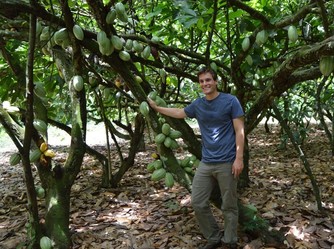|
Having trouble viewing this email? View it as a Web page.

|
|
|
Fresh from the
Field is a weekly album showcasing transformative impacts made by
partners supported by the National Institute of Food and Agriculture.
Editor: Falita Liles
May 17, 2018
|
|
Success Stories
 New
App Will Help Montanans Identify Mystifying Plants, Pests and Diseases
Montanans who might
otherwise text, email, or send samples through the mail to the Schutter
Diagnostic Lab at Montana State University may now use a phone app. The lab
provides identification services for plant diseases, insects, weeds, native
plants, and mushrooms.
Farmers who use the app
could, for example, take a digital photo of an abnormal wheat stem, then upload
the photo and fill out a form with their questions, extra details, and contact
information. The app will direct the query to the proper expert to determine
the cause and suggest possible remedies for the problem.
NIFA supports this project
through the National Plant Diagnostic Network.
Read
the full story at MSU News. Photo: USDA.
|

Penn State Improving the ‘Chocolate
Tree’
The cacao tree produces cocoa
beans, the raw material of chocolate. Reliable productivity from cacao plants
is essential to the multibillion-dollar chocolate industry, the economies of
producing countries, and the livelihoods of millions of smallholder cacao
farmers.
But each year, several
plant diseases severely limit global production, with 20-30 percent of cocoa
pods destroyed preharvest.
CRISPR (clustered
regularly interspaced short palindromic repeats) is a tool to modify an
organism's genome by precisely delivering a DNA-cutting enzyme, Cas9, to a
targeted region of DNA. The resulting change can delete or replace specific DNA
pieces, thereby promoting or disabling certain traits.
Previous work in cacao
identified a gene, known as TcNPR3, which suppresses the plant's disease
response. The researchers hypothesized that using CRISPR-Cas9 to knock out this
gene would result in enhanced disease resistance.
To test their hypothesis,
they used Agrobacterium — a plant pathogen modified to remove its ability to
cause disease — to introduce CRISPR-Cas9 components into detached cacao leaves.
Subsequent analysis of treated tissue found deletions in 27 percent of TcNPR3
copies.
NIFA supports the research through the Hatch Act Program.
Read the article at Penn State News. Photo: Andrew Fister with cacao trees Ivory Coast by Desire Pokou.
|
Library
 Dietary Patterns Related to Distinct Microbiota Composition in Children
Recent research has
uncovered more and more about the human gut microbiome, including which
microbes reside there and the functions they serve.
Nutrition researchers at
the University of Illinois are looking at possible links between dietary
patterns in children and their microbiota.
A new study looks at the
habitual dietary patterns of 4- to 8-year-old children and their microbiota
composition. Findings show that there is distinct microbiota composition based
on specific dietary patterns. A better understanding of how dietary patterns
impact the microbiome could help in developing nutrition-based therapies for
microbiota-related diseases.
NIFA supports this research through the Hatch
Act Program.
Read the full article at the
University of Illinois News. Photo: Getty Images.
|
Tweet of the Week
#NIFAIMPACTS

|
|

NIFA’s mission is to invest in and advance agricultural research, education, and extension that solve societal challenges. NIFA’s investments in transformative science directly support the long-term prosperity and global preeminence of U.S. agriculture. To learn more about NIFA’s impact on agricultural sciences, visit www.nifa.usda.gov/Impacts, sign up for email updates or follow us on Twitter @USDA_NIFA, #NIFAImpacts.
USDA is an equal opportunity lender, provider, and employer.
|
|